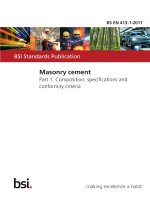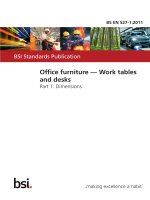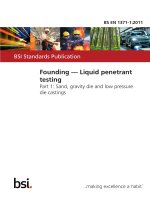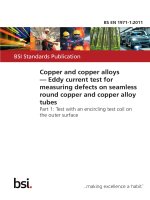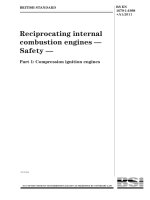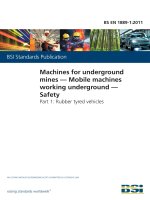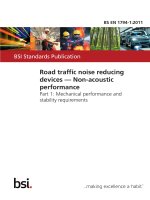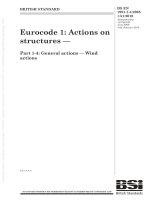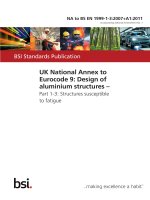Bsi bs en 61851 1 2011
Bạn đang xem bản rút gọn của tài liệu. Xem và tải ngay bản đầy đủ của tài liệu tại đây (1.49 MB, 58 trang )
BS EN 61851-1:2011
BSI Standards Publication
Electric vehicle conductive
charging system
Part 1: General requirements
NO COPYING WITHOUT BSI PERMISSION EXCEPT AS PERMITTED BY COPYRIGHT LAW
raising standards worldwide™
BRITISH STANDARD
BS EN 61851-1:2011
National foreword
This British Standard is the UK implementation of EN 61851-1:2011. It is
identical to IEC 61851-1:2010. It supersedes BS EN 61851-1:2001 which is
withdrawn.
The UK participation in its preparation was entrusted to Technical Committee
PEL/69, Electric vehicles.
A list of organizations represented on this committee can be obtained on
request to its secretary.
This publication does not purport to include all the necessary provisions of a
contract. Users are responsible for its correct application.
© BSI 2011
ISBN 978 0 580 64015 5
ICS 43.120
Compliance with a British Standard cannot confer immunity from
legal obligations.
This British Standard was published under the authority of the Standards
Policy and Strategy Committee on 31 August 2011.
Amendments issued since publication
Amd. No.
Date
Text affected
BS EN 61851-1:2011
EUROPEAN STANDARD
EN 61851-1
NORME EUROPÉENNE
EUROPÄISCHE NORM
August 2011
ICS 43.120
Supersedes EN 61851-1:2001
English version
Electric vehicle conductive charging system Part 1: General requirements
(IEC 61851-1:2010)
Système de charge conductive pour
véhicules électriques Partie 1: Règles générales
(CEI 61851-1:2010)
Elektrische Ausrüstung von ElektroStraßenfahrzeugen Konduktive Ladesysteme für
Elektrofahrzeuge Teil 1: Allgemeine Anforderungen
(IEC 61851-1:2010)
This European Standard was approved by CENELEC on 2011-04-12. CENELEC members are bound to comply
with the CEN/CENELEC Internal Regulations which stipulate the conditions for giving this European Standard
the status of a national standard without any alteration.
Up-to-date lists and bibliographical references concerning such national standards may be obtained on
application to the Central Secretariat or to any CENELEC member.
This European Standard exists in three official versions (English, French, German). A version in any other
language made by translation under the responsibility of a CENELEC member into its own language and notified
to the Central Secretariat has the same status as the official versions.
CENELEC members are the national electrotechnical committees of Austria, Belgium, Bulgaria, Croatia, Cyprus,
the Czech Republic, Denmark, Estonia, Finland, France, Germany, Greece, Hungary, Iceland, Ireland, Italy,
Latvia, Lithuania, Luxembourg, Malta, the Netherlands, Norway, Poland, Portugal, Romania, Slovakia, Slovenia,
Spain, Sweden, Switzerland and the United Kingdom.
CENELEC
European Committee for Electrotechnical Standardization
Comité Européen de Normalisation Electrotechnique
Europäisches Komitee für Elektrotechnische Normung
Management Centre: Avenue Marnix 17, B - 1000 Brussels
© 2011 CENELEC -
All rights of exploitation in any form and by any means reserved worldwide for CENELEC members.
Ref. No. EN 61851-1:2011 E
BS EN 61851-1:2011
EN 61851-1:2011
-2-
Foreword
The text of document 69/173/FDIS, future edition 2 of IEC 61851-1, prepared by IEC TC 69, Electric road
vehicles and electric industrial trucks, was submitted to the IEC-CENELEC parallel vote and was
approved by CENELEC as EN 61851-1 on 2011-04-12.
This European Standard supersedes EN 61851-1:2001.
The main changes with respect to EN 61851-1:2001 are the following:
– revision of connector definitions and current levels (Clause 8);
– modification definition of pilot wire to pilot function;
– division of Clause 9 to create Clauses 9 and 11;
– Clause 9: specific requirements for inlet, plug and socket–outlet;
– Clause 11: EVSE requirements: the basic generic requirements for charging stations;
– renumbering of annexes;
– deletion of previous Annex A and integration of charging cable requirements into new Clause 10;
– Annex B becomes Annex A and is normative for all systems using a PWM pilot function with a pilot
wire;
– Annex C becomes Annex B;
– replacement of previous Annex D (coding tables for power indicator) with B.4 in Annex B using new
values;
– new informative Annex C describing an alternative pilot function system.
Attention is drawn to the possibility that some of the elements of this document may be the subject of
patent rights. CEN and CENELEC shall not be held responsible for identifying any or all such patent
rights.
The following dates were fixed:
– latest date by which the EN has to be implemented
at national level by publication of an identical
national standard or by endorsement
(dop)
2012-01-01
– latest date by which the national standards conflicting
with the EN have to be withdrawn
(dow)
2014-04-01
Annexes ZA, ZB and ZC have been added by CENELEC.
__________
Endorsement notice
The text of the International Standard IEC 61851-1:2010 was approved by CENELEC as a European
Standard without any modification.
In the official version, for Bibliography, the following notes have to be added for the standards indicated:
IEC 60068-2-1:2007
NOTE Harmonized as EN 60068-2-1:2007 (not modified).
IEC 60068-2-14:2009
NOTE Harmonized as EN 60068-2-14:2009 (not modified).
IEC 60364-6:2006
NOTE Harmonized as HD 60364-6:2007 (modified).
-3IEC 60947-1:2007
NOTE Harmonized as EN 60947-1:2007 (not modified).
IEC 60947-6-1:2005
NOTE Harmonized as EN 60947-6-1:2005 (not modified).
IEC 61140
NOTE Harmonized as EN 61140.
IEC 61851-21
NOTE Harmonized as EN 61851-21.
IEC 61851-22
NOTE Harmonized as EN 61851-22.
__________
BS EN 61851-1:2011
EN 61851-1:2011
BS EN 61851-1:2011
EN 61851-1:2011
-4-
Annex ZA
(normative)
Normative references to international publications
with their corresponding European publications
The following referenced documents are indispensable for the application of this document. For dated
references, only the edition cited applies. For undated references, the latest edition of the referenced
document (including any amendments) applies.
NOTE When an international publication has been modified by common modifications, indicated by (mod), the relevant EN/HD
applies.
Publication
Year
Title
EN/HD
Year
-
-
Signalling on low-voltage electrical
installations in the frequency range 3 kHz to
148,5 kHz Part 1: General requirements, frequency
bands and electromagnetic disturbances
EN 50065-1
2001
IEC 60038 (mod)
2009
IEC standard voltages
FprEN 60038
IEC 60068-2-30
2005
EN 60068-2-30
Environmental testing Part 2-30: Tests - Test Db: Damp heat, cyclic
(12 h + 12 h cycle)
2005
IEC 60068-2-75
1997
Environmental testing Part 2-75: Tests - Test Eh: Hammer tests
EN 60068-2-75
1997
IEC 60068-2-78
2001
Environmental testing Part 2-78: Tests - Test Cab: Damp heat,
steady state
EN 60068-2-78
2001
IEC 60276
-
Definitions and nomenclature for carbon
brushes, brush-holders, commutators and
slip-rings
EN 60276
-
IEC 60309-1
1999
Plugs, socket-outlets and couplers for
industrial purposes Part 1: General requirements
EN 60309-1
+ A11
1999
2004
IEC 60309-2
1999
Plugs, socket-outlets and couplers for
industrial purposes Part 2: Dimensional interchangeability
requirements for pin and contact-tube
accessories
EN 60309-2
+ A11
1999
2004
IEC 60364-4-41
(mod)
2005
Low-voltage electrical installations Part 4-41: Protection for safety - Protection
against electric shock
HD 60364-4-41
+ corr. July
2007
2007
IEC 60529
1989
Degrees of protection provided by
enclosures (IP Code)
EN 60529
+ corr. May
1991
1993
IEC 60664-1
2007
Insulation coordination for equipment within
low-voltage systems Part 1: Principles, requirements and tests
EN 60664-1
2007
IEC/TR 60755
2008
General requirements for residual current
operated protective devices
-
-
IEC 60884-1
2002
Plugs and socket-outlets for household and
similar purposes Part 1: General requirements
-
-
1)
At draft stage.
1)
2011
BS EN 61851-1:2011
EN 61851-1:2011
-5Publication
IEC 60884-2-5
Year
1995
Title
Plugs and socket-outlets for household and
similar purposes Part 2: Particular requirements for adaptors
EN/HD
-
Year
-
IEC 60947-3
2008
Low-voltage switchgear and controlgear Part 3: Switches, disconnectors, switchdisconnectors and fuse-combination units
EN 60947-3
2009
IEC 60950-1 (mod) 2005
+ corr. August
2006
Information technology equipment - Safety Part 1: General requirements
EN 60950-1
+ A11
+ A12
2006
2009
2011
IEC 60990
1999
Methods of measurement of touch
current and protective conductor current
EN 60990
1999
IEC 61000-6-1
2005
Electromagnetic compatibility (EMC) Part 6-1: Generic standards - Immunity for
residential, commercial and light-industrial
environments
EN 61000-6-1
2007
IEC 61000-6-3
2006
Electromagnetic compatibility (EMC) EN 61000-6-3
Part 6-3: Generic standards - Emission
standard for residential, commercial and lightindustrial environments
2007
IEC 61008-1 (mod) 2010
Residual current operated circuit-breakers
without integral overcurrent protection for
household and similar uses (RCCB's) Part 1: General rules
FprEN 61008-1
200X
1)
IEC 61009-1 (mod) 2010
Residual current operated circuit-breakers
with integral overcurrent protection for
household and similar uses (RCBOs) Part 1: General rules
FprEN 61009-1
200X
1)
IEC 61180-1
1992
High-voltage test techniques for low-voltage
equipment Part 1: Definitions, test and procedure
requirements
EN 61180-1
1994
IEC 62196-1
2003
EN 62196-1
Plugs, socket-outlets, vehicle couplers and
vehicle inlets - Conductive charging of electric
vehicles Part 1: Charging of electric vehicles up to 250
A a.c. and 400 A d.c.
2003
ISO 6469-2
2009
Electrically propelled road vehicles - Safety
specifications Part 2: Vehicle operational safety means and
protection against failures
-
ISO 6469-3
2001
Electric road vehicles - Safety specifications - Part 3: Protection of persons against electric
hazards
-
SAE J1772
2010
Recommended practices: SAE Electric
Vehicle and Plug In Hybrid Electric Vehicle
Conductive Charge Coupler
-
-
BS EN 61851-1:2011
EN 61851-1:2011
-6-
Annex ZB
(normative)
Special national conditions
Special national condition: National characteristic or practice that cannot be changed even over a long
period, e.g. climatic conditions, electrical earthing conditions.
NOTE
If it affects harmonization, it forms part of the European Standard or Harmonization Document.
For the countries in which the relevant special national conditions apply these provisions are normative,
for other countries they are informative.
Clause
Special national condition
6.2
Germany
In Germany the inline control box (EVSE) shall be in the plug or located within
2,0 m of the plug.
6.3.3, Note 3
Finland
The use of adaptors from mode 1 socket outlets to mode 3 vehicle cable
assembly, that maintain the overall safety requirements of this standard is
allowed in Finland.
11.3.2, Note 1
Finland
In Finland IPXXD is not required for mode 1.
11.3.2, Note 1
The Netherlands
In The Netherlands IPXXD is not required for mode 1.
-7-
BS EN 61851-1:2011
EN 61851-1:2011
Annex ZC
(informative)
A-deviations
A-deviation: National deviation due to regulations, the alteration of which is for the time being outside the
competence of the CENELEC national member.
This European Standard does fall under LVD (2006/95/EC).
In the relevant CENELEC countries these A-deviations are valid instead of the provisions of the European
Standard until they have been removed.
Clause
Deviation
2
United Kingdom
IEC 60884-1 is not indispensable for the application of this document.
IEC 60884-1 is not applicable in UK.
The BS 1363 Series of standards applies to domestic socket-outlets, fused plugs, fused
connection units, fused conversion plugs and to adaptors in the UK.
6.2
Germany
Mode 1 cables without an in-cable RCD shall not be used but only Mode 1 cables with an
in-cable RCD.
All Mode 1 cables without an in-cable RCD shall bear the following safety information:
“Shall not be used in Germany".
Due to article 14 in the constitutional law of Germany which frames the preservation of
status quo of existing electrical installations it cannot be ensured that fixed electrical
installations at all times provide an RCD in Germany.
6.3.3
United Kingdom
IEC 60884-2-5 is not applicable in UK.
BS 1363-3 and BS 1363-5 apply to domestic adaptors and fused conversion plugs in the
UK.
9.1
United Kingdom
IEC 60884-1 is not applicable in UK.
The BS 1363 Series of standards applies to domestic socket-outlets, fused plugs, fused
connection units, fused conversion plugs and to adaptors in the UK.
9.2
United Kingdom
IEC 60884-1 is not applicable in UK.
The BS 1363 Series of standards applies to domestic socket-outlets, fused plugs, fused
connection units, fused conversion plugs and to adaptors in the UK.
9.3
United Kingdom
IEC 60884-1 is not applicable in UK.
The BS 1363 Series of standards applies to domestic socket-outlets, fused plugs, fused
BS EN 61851-1:2011
EN 61851-1:2011
-8-
connection units, fused conversion plugs and to adaptors in the UK.
11.6
United Kingdom
IEC 60884-1 is not applicable in UK.
The BS 1363 Series of standards applies to domestic socket-outlets, fused plugs, fused
connection units, fused conversion plugs and to adaptors in the UK.
__________
–2–
BS EN 61851-1:2011
61851-1 Ó IEC:2010
CONTENTS
1
Scope ...................................................................................................................... 7
2
Normative references ................................................................................................ 7
3
Terms and definitions ................................................................................................ 9
4
General requirements ............................................................................................. 13
5
Rating of the supply a.c. voltage .............................................................................. 13
6
General system requirement and interface ................................................................ 14
6.1
6.2
6.3
7
General description ........................................................................................ 14
EV charging modes ........................................................................................ 14
Types of EV connection using cables and plugs (cases A, B, and C) ................... 14
6.3.1 General description ............................................................................. 14
6.3.2 Cord extension set .............................................................................. 16
6.3.3 Adaptors ............................................................................................ 17
6.4 Functions provided in each mode of charging for modes 2, 3, and 4 .................... 17
6.4.1 Modes 2, 3 and 4 functions .................................................................. 17
6.4.2 Optional functions for modes 2, 3 and 4 ................................................. 17
6.4.3 Details of functions for modes 2, 3 and 4 ............................................... 18
6.4.4 Details of optional functions ................................................................. 18
6.4.5 Details of pilot function ........................................................................ 18
6.5 Serial data communication .............................................................................. 19
Protection against electric shock .............................................................................. 19
7.1
7.2
8
General requirements ..................................................................................... 19
Protection against direct contact ...................................................................... 19
7.2.1 General .............................................................................................. 19
7.2.2 Accessibility of live parts ...................................................................... 19
7.2.3 Stored energy – discharge of capacitors ................................................ 20
7.3 Protection against indirect contact ................................................................... 20
7.4 Supplementary measures................................................................................ 20
7.5 Provision for mode 4 EVSE ............................................................................. 20
7.6 Additional requirements .................................................................................. 21
Connection between the power supply and the EV ..................................................... 21
9
8.1 General ......................................................................................................... 21
8.2 Contact sequencing ........................................................................................ 23
8.3 Functional description of a standard interface ................................................... 23
8.4 Functional description of a basic interface ........................................................ 23
8.5 Functional description of a universal interface ................................................... 23
Specific requirements for vehicle inlet, connector, plug and socket-outlet ..................... 24
9.1 General requirements ..................................................................................... 24
9.2 Operating temperature .................................................................................... 24
9.3 Service life of inlet/connector and plug/socket-outlet .......................................... 24
9.4 Breaking capacity ........................................................................................... 24
9.5 IP degrees..................................................................................................... 24
9.6 Insertion and extraction force .......................................................................... 25
9.7 Latching of the retaining device ....................................................................... 25
10 Charging cable assembly requirements ..................................................................... 25
BS EN 61851-1:2011
61851-1 Ó IEC:2010
–3–
10.1 Electrical rating .............................................................................................. 25
10.2 Electrical characteristics ................................................................................. 25
10.3 Dielectric withstand characteristics .................................................................. 25
10.4 Mechanical characteristics .............................................................................. 25
10.5 Functional characteristics ............................................................................... 25
11 EVSE requirements ................................................................................................ 26
11.1 General test requirements ............................................................................... 26
11.2 Classification ................................................................................................. 26
11.3 IP degrees for basic and universal interfaces .................................................... 26
11.3.1 IP degrees for ingress of objects........................................................... 26
11.3.2 Protection against electric shock ........................................................... 27
11.4 Dielectric withstand characteristics .................................................................. 27
11.4.1 Dielectric withstand voltage .................................................................. 27
11.4.2 Impulse dielectric withstand (1,2/50 ms) ................................................. 28
11.5 Insulation resistance ...................................................................................... 28
11.6 Clearances and creepage distances ................................................................. 28
11.7 Leakage – touch current ................................................................................. 28
11.8 Environmental tests ........................................................................................ 29
11.8.1 General .............................................................................................. 29
11.8.2 Ambient air temperature....................................................................... 29
11.8.3 Ambient humidity ................................................................................ 29
11.8.4 Ambient air pressure ........................................................................... 30
11.9 Permissible surface temperature ...................................................................... 30
11.10 Environmental conditions.............................................................................. 30
11.11 Mechanical environmental tests .................................................................... 30
11.11.1 General ......................................................................................... 30
11.11.2 Mechanical impact .......................................................................... 30
11.12 Electromagnetic compatibility tests ................................................................ 31
11.13 Latching of the retaining device ..................................................................... 31
11.14 Service ....................................................................................................... 31
11.15 Marking and instructions .............................................................................. 31
11.15.1 Connection instructions ................................................................... 31
11.15.2 Legibility ........................................................................................ 31
11.15.3 Marking of electric vehicle charging station ........................................ 31
11.16 Telecommunication network .......................................................................... 32
Annex A (normative) Pilot function through a control pilot circuit using PWM
modulation and a control pilot wire ................................................................................. 33
Annex B (informative) Example of a circuit diagram for a basic and universal vehicle
coupler ........................................................................................................................ 39
Annex C (informative) Example of a method that provides the pilot function equivalent
to a hard wired system .................................................................................................. 46
Bibliography ................................................................................................................. 48
Figure 1 – Case "A" connection ...................................................................................... 15
Figure 2 – Case "B" connection ...................................................................................... 16
Figure 3 – Case "C" connection ..................................................................................... 16
Figure A.1 – Typical control pilot circuit .......................................................................... 33
Figure A.2 – Simplified control pilot circuit....................................................................... 34
–4–
BS EN 61851-1:2011
61851-1 Ó IEC:2010
Figure A.3 – Typical charging cycle under normal operating conditions .............................. 36
Figure B.1 – Mode 1 case B using the basic single phase vehicle coupler .......................... 40
Figure B.2 – Mode 2 case B using the basic single phase vehicle coupler .......................... 41
Figure B.3 – Mode 3 case B using the basic single phase vehicle coupler .......................... 41
Figure B.4 – Mode 3 case C using the basic single phase vehicle coupler .......................... 42
Figure B.5 – Mode 3 case B using the basic single phase vehicle coupler without
proximity push button switch S3 ..................................................................................... 43
Figure B.6 – Diagram for current capability coding of the cable assembly ........................... 44
Figure B.7 – Mode 4 case C using the universal vehicle coupler ........................................ 45
Figure C.1 – Example of a pilot function without a supplementary wire ............................... 46
Table 1 – Overview of the vehicle interface options and suggested contact ratings .............. 22
Table 2 – Touch current limits ........................................................................................ 29
Table A.1 – EVSE control pilot circuit parameters (see Figures A.1 and A.2) ...................... 34
Table A.2 – Vehicle control pilot circuit values and parameters (see Figures A.1, A.2) ......... 35
Table A.3 – Pilot functions ............................................................................................. 35
Table A.4 – description of connecting sequences as shown on Figure A.3 .......................... 36
Table A.5 – Pilot duty cycle provided by EVSE ................................................................ 37
Table A.6 – Maximum current to be drawn by vehicle ....................................................... 37
Table A.7 – EVSE timing (see Figure A.3) ....................................................................... 38
Table B.1 – Identification of components used with basic single phase connector ............... 40
Table B.2 – Component values for all drawings ............................................................... 42
Table B.3 – Resistor coding for vehicle connectors and plugs ........................................... 43
Table B.4 – Component description for Figure B.7 mode 4 case C ..................................... 44
BS EN 61851-1:2011
61851-1 Ó IEC:2010
–7–
ELECTRIC VEHICLE CONDUCTIVE CHARGING SYSTEM –
Part 1: General requirements
1
Scope
This part of IEC 61851 applies to on-board and off-board equipment for charging electric road
vehicles at standard a.c. supply voltages (as per IEC 60038) up to 1 000 V and at d.c.
voltages up to 1 500 V, and for providing electrical power for any additional services on the
vehicle if required when connected to the supply network.
Electric road vehicles (EV) implies all road vehicles, including plug in hybrid road vehicles
(PHEV), that derive all or part of their energy from on-board batteries.
The aspects covered include characteristics and operating conditions of the supply device
and the connection to the vehicle; operators and third party electrical safety, and the
characteristics to be complied with by the vehicle with respect to the a.c./d.c. EVSE, only
when the EV is earthed.
NOTE 1 Class II vehicles are not defined, but the lack of information for this type of vehicle means that th e
requirements for the standard are under c onsideration.
NOTE 2
This standard als o applies to EVSE with on-site storage capability.
Requirements for specific inlet, connector, plug and socket-outlets for EVs are contained in
IEC 62196-1:2003. Standard sheets for the vehicle connector and inlet are also under
consideration. They will be incorporated in a separate part of standard IEC 62196 .
This standard does not cover all safety aspects related to maintenance.
This standard is not applicable to trolley buses, rail vehicles, industrial trucks and v ehicles
designed primarily for use off-road.
2
Normative references
The following referenced documents are indispensable for the application of this document.
For dated references, only the edition cited applies. For undated references, the latest edition
of the referenced document (including any amendments) applies.
IEC 60038:2009, IEC standard voltages
IEC 60068-2- 30:2005, Environmental testing – Part 2-30: Tests – Test Db: Damp heat, cyclic
(12 + 12 h cycle)
IEC 60068-2-75:1997, Environmental testing – Part 2: Tests – Test Eh: Hammer tests
IEC 60068-2- 78:2001, Environmental testing – Part 2-78: Tests – Test Cab: Damp heat, steady
state
IEC 60276, Definitions and nomenclature for carbon brushes, brush-holders, commutators
and slip-rings
IEC 60309-1:1999, Plugs, socket-outlets and couplers for industrial purposes – Part 1:
General requirements
–8–
BS EN 61851-1:2011
61851-1 Ó IEC:2010
IEC 60309-2:1999, Plugs, socket-outlets and couplers for industrial purposes – Part 2:
Dimensional interchangeability requirements for pin and contact-tube accessories
IEC 60364-4-41:2005, Low-voltage electrical installations – Part 4-41: Protection for safety –
Protection against electric shock
IEC 60529:1989, Degrees of protection provided by enclosures (IP Code)
IEC 60664-1:2007, Insulation coordination for equipment within low-voltage systems – Part 1:
Principles, requirements and tests
IEC/TR 60755:2008, General requirements for residual current operated protective devices
IEC 60884-1:2002, Plugs and socket-outlets for household and similar purposes – Part
1:General requirements
IEC 60884-2-5:1995, Plugs and socket-outlets for household and similar purposes – Part 2
particular requirements for adaptors
IEC 60947-3:2008, Low-voltage sw itchgear and controlgear –
disconnect ors, switch-disconnectors and fuse-combination units
Part 3: Switches,
IEC 60950-1:2005, Information technology equipment – Safety – Part 1: General requirements
IEC 60990:1999, Methods of measurement of touch current and protective conductor current
IEC 61000-6-1:2005, Electromagnetic compatibility (EMC) – Part 6-1: Generic
standards – Immunity for residential, commercial and light-industrial environments
IEC 61000-6-3:2006, Electromagnetic
standards – Emission standard for
environments
compatibility (EMC) – Part 6-3: Generic
residential, commercial and light-industrial
IEC 61008-1:2010, Residual curr ent operated circuit-br eakers wit hout integral
overcurr ent protection for household and similar uses ( RCCBs) – General rules
IEC 61009-1:2010, Residual curr ent operated circuit-breakers wit h integral overcurr ent
protection for household and similar uses (RCBOs) – General rules
IEC 61180-1:1992, High-voltage test techniques for low-voltage equipment – Part 1:
definitions, test and procedure requirements
IEC 62196-1:2003, Plugs, socket-outlets, vehicle couplers and vehicle inlets – Conductive
charging of electric vehicles – Part 1: Charging of electric vehicles up to 250 A a.c. and 400 A d.c.
ISO 6469-2:2009, Electrically propelled road vehicles – Safety specifications – Part 2: Vehicle
operational safety means and protection against failures
ISO 6469-3:2001, Electric road vehicles – Safety specifications – Part 3: Protection of
persons against electric hazards
EN 50065-1:2001, Signalling on low-voltage electrical installations in the frequency range
3 kHz to 148,5 kHz – Part 1: General requirements, frequency bands and electromagnetic
disturbances
BS EN 61851-1:2011
61851-1 Ó IEC:2010
–9–
SAE J1772:2010, Recommended practices: SAE Electric Vehicle and Plug In Hybrid Electric
Vehicle Conductive Charge Coupler
3
Terms and definitions
For the purposes of this document, the following terms and definitions apply.
3.1
basic insulation
insulation of hazardous-live-parts which provides basic protection
3.2
cable assembly
piece of equipment used to establish the connection between the EV and socket-outlet (in
case A and case B) or to the fixed charger (in case C)
NOTE 1
It may be either fixed or be included in the vehicle or the EVSE, or detachable.
NOTE 2
It includes the flexible c able and the c onnector and/or plug that are required for proper c onnection.
NOTE 3
See Figures 1 to 3 for description of cases A, B and C.
NOTE 4
A detachable c able assembly is not considered as a part of the fixed installation.
3.3
charger
power converter that performs the necessary functions for charging a battery
3.3.1
class I charger
charger with basic insulation as provision for basic protection and protective bonding as
provision for fault protection
NOTE Protective bonding consists of connection of all expos ed conductive parts to the charger earth terminal.
3.3.2
class II charger
charger with
–
basic insulation as provision for basic protection, and
–
supplementary insulation as provision for fault protection,
or in which
–
basic and fault protection are provided by reinforced insulation
3.3.3
off-board charger
charger connected to the premises wiring of the a.c. supply network (mains) and designed to
operate entirely off the vehicle. In this case, direct current electrical power is delivered to the
vehicle
3.3.3.1
dedicated off-board charger
off-board charger designed to be used only by a specific type of EV, which may have control
charging functions and/or communication
3.3.4
on-board charger
charger mounted on the vehicle and designed to operate only on the vehicle
– 10 –
BS EN 61851-1:2011
61851-1 Ó IEC:2010
3.4
charging
all functions necessary to condition standard voltage and frequency a.c. supply current to a
regulated voltage/current level to assure proper charging of the EV traction battery and/or
supply of energy to the EV traction battery bus, for operating on-board electrical equipment in
a controlled manner to assure proper energy transfer
3.5
connection
single conductive path
3.6
control pilot
the control conductor in the cable assembly connecting the in-cable control box or the fixed
part of the EVSE, and the EV earth through the control circuitry on the vehicle. It may be used
to perform several functions
3.7
earth terminal
accessible connection point for all exposed conductive parts electrically bound together
NOTE
In the U.S.A., the term "ground" is used instead of "earth".
3.8
electric vehicle
EV
electric road vehicle (ISO)
any vehicle propelled by an electric motor drawing current from a rechargeable storage
battery or from other portable energy storage devices (rechargeable, using energy from a
source off the vehicle such as a residential or public electric service), which is manufactured
primarily for use on public streets, roads or highways
3.8.1
class I EV
an EV with basic insulation as provision for basic protection and protective bonding as
provision for fault protection
NOTE This consists of connection of all expos ed c onductive parts to the EV earth terminal.
3.8.2
class II EV
EV in which protection against electric shock does not rely on basic insulation only, but in
which additional safety precautions, such as double insulation or reinforced insulation, are
provided, there being no provision for protective earthing or reliance upon installation
conditions
3.9
EV supply equipment
EVSE
conductors, including the phase, neutral and protective earth conductors, the EV couplers,
attachment plugs, and all other accessories, devices, power outlets or apparatuses installed
specifically for the purpose of delivering energy from the premises wiring to the EV and
allowing communication between them if required
3.9.1
a.c. EV charging station
all equipment for delivering a.c. current to EVs, installed in an enclosure(s) and with special
control functions
BS EN 61851-1:2011
61851-1 Ó IEC:2010
– 11 –
3.9.2
d.c. EV charging station
all equipment for delivering d.c. current to EVs, installed in an enclosure(s), with special
control functions and communication and located off the vehicle
NOTE DC charging includes pulse mode charging.
3.9.3
exposed conductive part
conductive part of equipment, which can be touched and which is not normally live, but which
can become live when basic insulation fails
3.9.4
direct contact
contact of persons with live parts
3.9.5
indirect contact
contact of persons with exposed conductive parts made live by an insulation failure
3.10
live part
any conductor or conductive part intended to be electrically energized in normal use
3.10.1
hazardous live part
live part, which under certain conditions, can result in an electric shock
3.11
in-cable control box
a device incorporated in the cable assembly, which performs control functions and safety
functions
NOTE The in-cable c ontrol box is located in a detachable cable assembly or plug that is not part of the fixed
installation.
3.12
plug and socket-outlet
means of enabling the manual connection of a flexible cable to fixed wiring
NOTE It consists of two parts: a socket-outlet and a plug.
3.12.1
plug
part of a plug and socket-outlet integral with or intended to be attached to the flexible cable
connected to the socket-outlet
3.12.2
socket-outlet
part of a plug and socket-outlet intended to be installed with the fixed wiring
3.13
power indicator
resistor value identifying supply rating recognition by the vehicle
3.14
retaining device
mechanical arrangement which holds a plug or connector in position when it is in proper
engagement, and prevents unintentional withdrawal of the plug or connector
– 12 –
NOTE
BS EN 61851-1:2011
61851-1 Ó IEC:2010
The retaining devic e can be electrically or mechanically operated.
3.15
vehicle coupler
means of enabling the manual connection of a flexible cable to an EV for the purpose of
charging the traction batteries
NOTE It consists of two parts: a vehicle c onnector and a vehicle inlet.
3.15.1
vehicle connector
part of a vehicle coupler integral with, or intended to be attached to, the flexible cable
connected to the a.c. supply network (mains)
3.15.2
vehicle inlet
part of a vehicle coupler incorporated in, or fixed to, the EV or intended to be fixed to it
3.16
function
any means, electronic or mechanical, that insure that the conditions related to the safety or
the transmission of data required for the mode of operation are respected
3.17
pilot function
any means, electronic or mechanical, that insures the conditions related to the safety or the
transmission of data required for the mode of operation
3.18
proximity function
a means, electrical or mechanical, in a coupler to indicate the presence of the vehicle connector
to the vehicle
3.19
standardized socket-outlet
socket-outlet which meets the requirements of any IEC and/or national standard
3.20
residual current device
RCD
mechanical switching device designed to make, carry and break currents under normal
service conditions and to cause the opening of the contacts when the residual current attains
a given value under specified conditions
NOTE 1 A residual current device can be a combination of various separate elements designed to detect and
evaluate the residual current and to make and break current.
NOTE 2 In the following countries an RCD may be either electrical, electronic, mechanic al or a combination
thereof: US, JP, UK.
[IEC 60050-44:1998, 442-05-02]
3.21
pulse mode charging
charging of storage batteries using modulated direct current
3.22
standard interface
interface that is defined by any of the following standards IEC 60309-1, IEC 60309-2, or
IEC 60884-1 and/or national standard having an equivalent scope, and is not fitted with any
supplementary pilot or auxiliary contacts
BS EN 61851-1:2011
61851-1 Ó IEC:2010
– 13 –
3.23
basic interface
interface as defined by the IEC 62196-1 and for which a functional description is given in 8.4
3.24
universal interface
interface as defined by the IEC 62196-1 and for which a functional description is given in 8.5
3.25
plug in hybrid electric road vehicle
PHEV
any electrical vehicle that can charge the rechargeable electrical energy storage device from
an external electric source and also derives part of its energy from an other source
3.26
cord extension set
assembly consisting of a flexible cable or cord fitted with both a plug and a connector of a
standard interface type
NOTE
A mode 2 or a mode 1 cable assembly is not c onsidered as a cord extension set.
3.27
adaptor
a portable accessory constructed as an integral unit incorporating both a plug portion and one
socket-outlet
NOTE The socket-outlet may accept different configurations and ratings.
3.28
indoor use
equipment designed to be exclusively used in a weather protected locations
3.29
outdoor use
equipment designed to be allowed to be used in non weather protected locations
4
General requirements
The EV shall be connected to the EVSE so that in normal conditions of use, the conductive
energy transfer function operates safely.
In general, this principle is achieved by fulfilling the relevant requirements specified in this
standard, and compliance is checked by carrying out all relevant tests.
5
Rating of the supply a.c. voltage
The rated value of the a.c. supplied voltage for the charging equipment is up to 1 000 V. The
equipment shall operate correctly within ±10 % of the standard nominal voltage. The rated
value of the frequency is 50 Hz ± 1 % or 60 Hz ± 1 % .
NOTE
Nominal voltage values can be found in IEC 60038.
BS EN 61851-1:2011
61851-1 Ó IEC:2010
– 14 –
6
General system requirement and interface
6.1
General description
One method for EV charging is to connect the a.c. supply network (mains) to an on-board
charger. An alternative method for charging an EV is to use an off-board charger for
delivering direct current. For charging in a short period of time, special charging facilities
operating at high power levels could be utilized.
6.2
EV charging modes
A residual current device with characteristics that are at least equivalent to type A as defined
in IEC 61008-1 or IEC 61009-1, or IEC/TR 60755 in conjunction with an over-current
protection device shall be required for all modes of charging.
NOTE 1
Some vehicle electric topologies may require additional protection on the vehicle.
Mode 1 charging: connection of the EV to the a.c. supply network (mains) utilizing
standardized socket-outlets not exceeding 16 A and not exceeding 250 V a.c. single-phase or
480 V a.c. three-phase, at the supply side, and utilizing the power and protective earth
conductors.
NOTE 2
In the following countries, mode 1 charging is prohibited by national codes: US.
NOTE 3 The use of an in-cable RCD can be us ed to add supplementary protection for connection to existing a.c.
supply networks.
NOTE 4 Some c ountries may allow the us e of an RCD of type AC for mode 1 vehicles connected to existing
domestic installations: JP, SE.
Mode 2 charging: connection of the EV to the a.c. supply network (mains) not exceeding
32 A and not exceeding 250 V a.c. single-phase or 480 V a.c. three-phase utilizing
standardized single-phase or three-phase socket-outlets, and utilizing the power and
protective earth conductors together with a control pilot function and system of personnel protection
against electric shock (RCD) between the EV and the plug or as a part of the in-cable control box. The
inline control box shall be located within 0,3 m of the plug or the EVSE or in the plug.
NOTE 5 In the USA, a devic e which measures leakage current over a range of frequencies and trips at predefined levels of leakage current, bas ed upon the frequenc y is required.
NOTE 6 In the following countries, according to national codes, additional requirements are nec essary to allow
cord and plug connection to a.c. supply networks greater than 20 A, 125 V a.c.: US.
NOTE 7
For
mode
2,
portable
RCD
as
defined
in
IEC 61540
and
IEC 62335
NOTE 8
In Germany the inline control box (EVSE) shall be in the plug or located within 2,0 m of the plug.
is
applicable.
Mode 3 charging: connection of the EV to the a.c. supply network (mains) utilizing dedicated
EVSE where the control pilot function extends to control equipment in the EVSE, permanently
connected to the a.c. supply network (mains) .
Mode 4 charging: connection of the EV to the a.c. supply network (mains) utilizing an offboard charger where the control pilot function extends to equipment permanently connected
to the a.c. supply.
6.3
6.3.1
Types of EV connection using cables and plugs (cases A, B, and C)
General description
The connection of EVs using cables may be carried out in one or more of three different ways:
BS EN 61851-1:2011
61851-1 Ó IEC:2010
– 15 –
a) Case "A" connection: the connection of an EV to the a.c. supply network (mains) utilizing a
supply cable and plug permanently attached to the EV (see Figure 1).
b) Case "B" connection: the connection of an EV to the a.c. supply network (mains) utilizing a
detachable cable assembly with a vehicle connector and a.c. supply equipment (see
Figure 2).
Case B1 corresponds to a connection to wall mounted socket.
Case B2 corresponds to a specific charging station.
c) Case "C" connection: the connection of an EV to the a.c. supply network (mains) utilizing a
supply cable and vehicle connector permanently attached to the supply equipment (see
Figure 3). Only case "C" is allowed for mode 4 charging .
NOTE
Specific mechanic al connecting systems can be utilized instead of cables and plug.
Socket outlet
Plug and scocket outlet
Plug
Flexible cable
On-board charger
Traction battery
Charging station
Earth terminal
Plug
Domestic, industrial dedicated
socket outlet
EVSE
IEC 2374/10
Connection of an EV to an a.c. supply utilizing supply cable and plug permanently attached to the EV
A1: charging cable c onnected to a domestic or industrial socket
A2: charging cable c onnected to a specific charging station
Figure 1 – Case "A" connection
BS EN 61851-1:2011
61851-1 Ó IEC:2010
– 16 –
Socket outlet
Plug and scocket outlet
Plug
Flexible cable
On-board charger
Traction battery
Case B2
Electrical vehicle
inlet
Charging station
Connector
Case B1
Plug
Earth terminal
Electrical vehicle coupler
Domestic, industrial dedicated
socket outlet
EVSE
IEC 2375/10
Connection of an EV to an a.c. supply utilizing a detachable cable assembly with a vehicle c onnector and a.c.
supply equipment
B1:
charging c able c onnected to a domestic or industrial s ocket
B2:
charging c able c onnected to a specific charging station
Figure 2 – Case "B" connection
Flexible cable
On-board charger
Traction battery
Electrical vehicle
inlet
Charging station
Connector
Earth terminal
Electrical vehicle coupler
EVSE
IEC 2376/10
Connection of an EV to a.c. supply utilizing supply cable and connector permanently attached to the suppl y
equipment
Figure 3 – Case "C" connection
6.3.2
Cord extension set
A cord extension set or second cable assembly shall not be used in addition to the cable
assembly for the connection of the EV to the EVSE. The vehicle manual shall clearly indicate
this. A cable assembly shall be so constructed so that it cannot be used as a cord extension
set.
NOTE
As in IEC 62196-1, plugs and connectors are designed not be intermateable.
BS EN 61851-1:2011
61851-1 Ó IEC:2010
6.3.3
– 17 –
Adaptors
Adaptors shall not be used to connect a vehicle connector to a vehicle inlet.
A conversion adaptor from the socket outlet of the EVSE shall only be used if specifically
designated and approved by the vehicle manufacturer or by the EVSE manufacturer. Such
adaptors shall be comply with the requirements of this standard, IEC 60884-2-5 and the other
relevant Standards governing either the plug or socket-outlet portions of the adaptor. The
manufacturer shall clearly indicate the obligation to use adaptors with such a specific
designation. Such adaptors shall be marked to indicate their specific conditions of use. Such
adaptors shall not allow transitions from one mode to another. They shall meet the
requirements of this standard and IEC 62196-1.
NOTE 1
Specific mechanic al connecting systems can be utilized instead of cables and plug.
NOTE 2 In some c ountries the c onnection between the in-c able control box and the socket outlet may be made by
means of a removable adaptor cord of less than 30 cm in length , using non rewireable accessories: JP, FR.
NOTE 3 The use of adaptors from mode 1 socket outlets to mode 3 vehicle cable assembly, that maintain th e
overall safety requirements of this standard is allowed in the following countries: IT, SE, BE, FR, CH.
NOTE 4 Short cord extension s ets, with no mode change, of less than 30 cm in length may be us ed on the EVSE
in the following c ountries: SE.
6.4
Functions provided in each mode of charging for modes 2, 3, and 4
6.4.1
Modes 2, 3 and 4 functions
These functions shall be provided by the EVSE or the EVSE and vehicle system as given
below:
·
verification that the vehicle is properly connected;
·
continuous protective earth conductor continuity checking;
·
energization of the system;
·
de-energization of the system.
NOTE 1 The pilot functions can be achieved using PW M pilot c ontrol as described in Annex A or any other non
PW M system that provides the same results. An example is provided in Annex C.
NOTE 2
Specific communication and functions for mode 4 is described in IEC 61851-23.
NOTE 3
Some of these functions may also exist for mode 1 charging.
6.4.2
Optional functions for modes 2, 3 and 4
The following functions should be provided by the EVSE or the EVSE and vehicle system as
given below:
–
selection of charging rate;
–
determination of ventilation requirements of the charging area;
–
detection/adjustment of the real time available load current of the supply equipment;
–
retaining/releasing of the coupling;
–
control of bi-directional power flow to and from the vehicle.
Other additional functions may be provided.
NOTE 1
system.
Un-intentional live disconnect avoidanc e functions may be incorporated in the latching function interloc k
NOTE 2
A positive means to prevent an intentional disconnect is required in s ome c ountries: US.
NOTE 3
Charging rate is mandatory for pilot functions using PW M signals as described in normative Annex A.
– 18 –
NOTE 4
BS EN 61851-1:2011
61851-1 Ó IEC:2010
Some of these functions may also exist for mode 1 charging.
6.4.3
Details of functions for modes 2, 3 and 4
6.4.3.1
Verification that the vehicle is properly connected
The EVSE shall be able to determine that the connector is properly inserted in the vehicle
inlet and properly connected to the EVSE.
Vehicle movement by its own propulsion system shall be impossible as long as the vehicle is
physically connected to the EVSE as required in ISO 6469-2.
6.4.3.2
Continuous protective earth continuity checking
Equipment earth continuity between the EVSE and the vehicle shall be continuously verified.
6.4.3.3
Energization of the system
Energization of the system shall not be performed until the pilot function between EVSE and
EV has been established correctly.
Energization may also be subject to other conditions being fulfilled.
6.4.3.4
De-energization of the system
If the pilot function is interrupted, the power supply to the cable assembly shall be interrupted
but the control circuit may remain energized.
6.4.4
Details of optional functions
6.4.4.1
Determination of ventilation requirements during charging
If additional ventilation is required during charging, charging shall only be allowed if such
ventilation is provided.
6.4.4.2
Detection/adjustment of the real time available load current of EVSE
Means shall be provided to ensure that the charging rate shall not exceed the real time
available load current of the EVSE and its power supply.
NOTE
The function of 6.4.4.2 may be required under certain national c odes.
6.4.4.3
Retaining/releasing of the coupler
A mechanical means shall be provided to retain/release the coupler.
6.4.4.4
Selection of charging rate
A manual or automatic means shall be provided to ensure that the charging rate does not
exceed the rated capacity of the a.c. supply network (mains), vehicle or battery capabilities.
6.4.4.5
Details of optional functions for mode 3
Bi-directional power flow requires additional control functions that are not treated in this
edition.
6.4.5
Details of pilot function
For modes 2, 3 and 4, a pilot function is mandatory.
